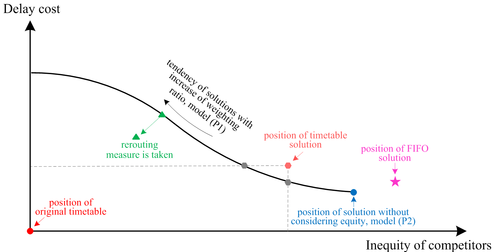Equity and competition in railway traffic control disruption management
Equity and competition in railway traffic control and disruption management
The problem of dispatching trains on a general railway network during delayed operations is considered. An innovative aspect of the problem, namely the fairness of the control decisions, is investigated, to deliver equitable solutions when multiple Train Operating Companies (TOCs) are present.
Railway organisational policy from the EU sees competition among TOCs as a key element to achieve efficient operations. Nevertheless, situations of quasi-monopoly are common, which may result in discriminatory or unfair treatment among different TOCs. The competitive interaction, related to fairness and unfairness, between Infrastructure Manager and multiple TOCs has been studied so far mostly from policy and financing point of view. On the other hand, no online (i.e. in relation with actual operation, delays and disruptions) approach is known to address this problem.
To this end, innovative mixed integer linear programming models are developed for dispatching trains, which minimize average train delay time and delay inequity among competing TOCs (or trains). Equity is the degree of homogeneity of the delays faced by different trains, or trains of different TOCs. An inequitable situation occurs when some trains, or some TOCs, face much larger delays than other trains or TOCs. Mathematical optimization models for railway traffic control can include fairness in the objective function, or as a set of constraints.

Preliminary experiments test the efficiency and effectiveness of the proposed models. In general, the newly developed equitable models provide solutions with much higher equity compared to the other solutions such as the common benchmark First-In First Out (FIFO) solution, and the solution keeping the timetable order. Including rerouting trains might allow simultaneous improvement of delays and equity. In general, considering equity results in larger delay costs and longer solution time.
This work is supported by the State Key Laboratory of Rail Traffic Control and Safety, Beijing Jiaotong University (No. RCS2012K004, RCS2013ZZ001), Fundamental Research Funds for the Central Universities (No. 2014JBZ008), and National Natural Science Foundation of China (No. 71201009).
For more details, please contact Dr. Ir. Francesco Corman, f.corman@tudelft.nl